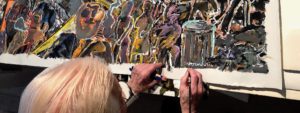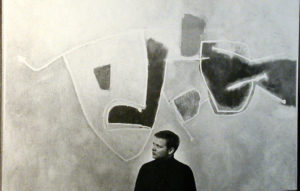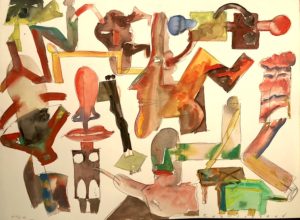 A 76-page catalogue and a 352-page hardcover book on the life and art of Harry Bertschmann will be released in 2021. Please send us an email for more details.
A 76-page catalogue and a 352-page hardcover book on the life and art of Harry Bertschmann will be released in 2021. Please send us an email for more details.
Harry Bertschmann was born in Basel, Switzerland, on March 27, 1931, but has lived and worked most of his life in New York City. As a youth growing up after World War II he was immersed in Basel’s dozens of museums for the fine arts. The Kunstmuseum Basel gave him exposure to one of the great collections in the world spanning all periods. He was also impressed by art found in the extensive ethnographic collections at the Basel Museum of Cultures, especially the boldly carved and painted objects from New Guinea’s Sepik River region.
In 1947 Bertschmann began four years of study at the Basel School of Design (Kunstgewerbeschule) under a staff of well-known art instructors. Of particular importance and influence was the graphic design department, led by Armin Hofmann [b.1920] whose collaborating instructor was the great typographer Emil Ruder [1914-1970]. They were reinforced by Donald Brun [1909-1999], another of the world’s most famous poster designers. Hofmann, who later taught at Yale, is credited for having developed the Swiss Style in graphic design — noted for its dynamic compositions, innovative use of color, and unique sans serif fonts. The school also provided the advantage of tapping a large and significant poster collection as a teaching aid, and its holdings dated back to the late nineteenth century. Bertschmann’s other influentual teachers included the abstract painters Theo Eble [1899-1974], Walter Bodmer [1903-1973], and Ernst Büchner [1886-1951]. In his final year Bertschmann also apprenticed with Fritz Bühler [1909–1963], the foremost innovator in conceptual graphic design.

In 1951, after graduating first in his class, Bertschmann left Basel and took a job in Fond du Lac, Wisconsin, north of Milwaukee. Soon, however, he accepted a position in Cleveland as a graphic designer. It was a career in which he would gain significant success, resulting in his double life as he persisted in developing his own abstract expressionist style of painting. On a trip to South Dakota he was inspired by the petrographs (pictographs) carved in the cave walls of the by the earliest Native Americans — which proved to be the catalyst for his first major group of paintings from 1956: The Magnolia Series, named for the street of his studio in Cleveland. His first champion was Henry J. Kurth [1917–1999], an internationally known set designer in Cleveland. Kurth curated two solo exhibitions for Bertschmann at the avant-garde Howard Wise Gallery, which would later move to New York and pioneer in kinetic art.1 Bertschmann soon achieved success as a young man with a first prize at the Cleveland Museum of Art. Consequently, in 1958 he was accepted to the prestigious Bicentennial in Pittsburgh known as the Carnegie International. At only twenty-seven, he was the youngest exhibitor, and one of his large canvases hung beside those by members of the first generation of the New York School — all of whom were then in their prime, such as Mark Rothko [1903–1970], Franz Kline [1910–1962], Barnet Newman [1905–1970], Philip Guston [1913–1980], and Robert Motherwell [1915–1991].
However, Bertschmann never got to attend the Carnegie International because in 1956 he was drafted into the U.S. Army and sent to Europe. Fortunately, because he was assigned to create graphics and posters he also found the time to paint. During the next few years produced his seminal Stuttgart Series. Here bold geometric shapes painted on a firm paperboard (consistently 18 x 26 inches) are structured in a dynamic dialogue that is softened by warm earth tones and a chalky texture owing to the use of natural powder pigments.
After his stint in the Army, Bertschmann returned briefly to Cleveland in 1962 before deciding to move to New York and settle in Greenwich Village. There he and his wife started the Bank Street Press, an independent publisher of poetry and children’s books. Throughout the 1960s his wife served as editor and he was the designer. Still, painting remained his primary interest. His inclination to paint in series is best exemplified by The Bank Street Paintings from 1978–1985. However, few critical eyes ever became aware of his work because he never actively sought gallery representation. Even in 1986 after Henry Geldzahler, the former curator of the Metropolitan Museum of Art, had made a serendipitous studio visit and strongly expressed his admiration for the paintings, Bertschmann never felt compelled to take advantage of the connection.

Finally, in 1997 Swiss colleagues arranged for a retrospective at the Gewerbeverband Basel-Stadt of Bertschmann’s highly visible career in design as well as his relatively hidden life in painting. The exhibition’s 140 works featured a wide range that illuminated the brilliance of his double lives. One life, that which supported him, produced numerous graphic designs of commercial logos and packaging — many of which have become iconic in American culture — such as those for Kent and Newport cigarettes, Nestlé’s, and Bufferin. At the other end of the spectrum his other life pushed the boundaries of abstract expressionist painting. Perhaps this is why art historian and critic Robert C. Morgan has aptly described Bertschmann as “an art world outsider looking inward” who possesses the unusual depth of ability “to work in many styles and visual terrains, whether figurative or abstract, expressionist or hard edge, surrealist or constructivist.”
A package designer for major corporate accounts by day, Bertschmann was by night creating paintings on canvas and on paper in series. With titles such as the Subway Series, the Haikus Series, and Ab Ex Shapes, these series range from figurative expressionism to hard edge paintings. Bertschmann has even proven the ability to circle back to reprise abstract expressionism or more deftly release the powerful graphic potential of graffiti. Ultimately, these works have extraordinary staying power. There are no one-liners here, so easy to grasp, as are Andy Warhol’s assembly line screenprints. Rather, a Bertschmann painting compels the viewer to linger — and upon returning find invigoration anew.
Peter Hastings Falk

FOOTNOTES
1 The Howard Wise Gallery of Present Day Painting and Sculpture operated in Cleveland from 1957–1961 and as the Howard Wise Gallery in New York City from 1960–1970. In New York, Wise was an early pioneer in supporting technology in art with groundbreaking exhibitions of kinetic and light sculpture, video art, and multimedia by artists such as Len Lye, Takis, Jean Tinguely, and Group Zero. Wise closed the gallery in 1970 to found the nonprofit organization Electronic Arts Intermix.
